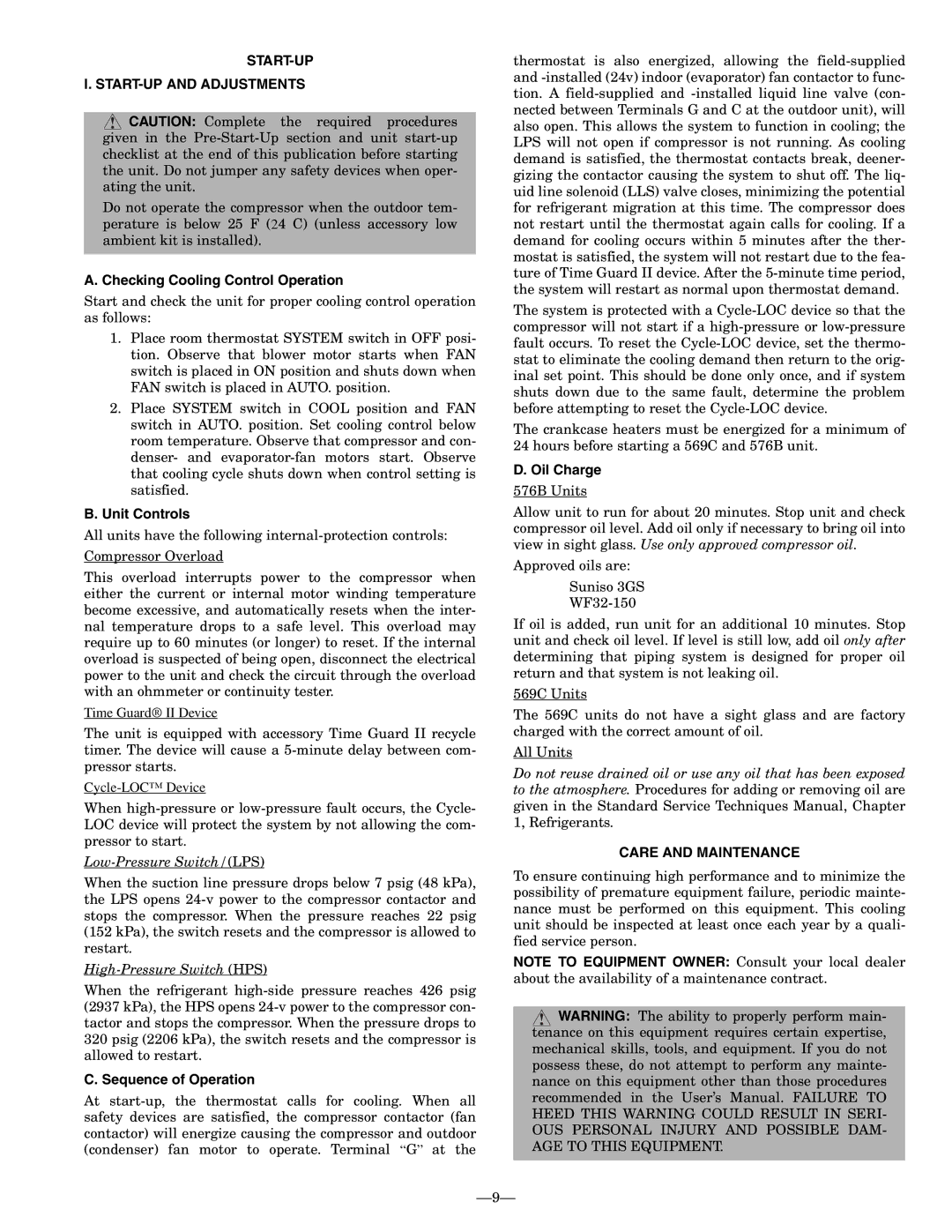
START-UP
I. START-UP AND ADJUSTMENTS
![]() CAUTION: Complete the required procedures given in the
CAUTION: Complete the required procedures given in the
Do not operate the compressor when the outdoor tem- perature is below 25 F (24 C) (unless accessory low ambient kit is installed).
A. Checking Cooling Control Operation
Start and check the unit for proper cooling control operation as follows:
1.Place room thermostat SYSTEM switch in OFF posi- tion. Observe that blower motor starts when FAN switch is placed in ON position and shuts down when FAN switch is placed in AUTO. position.
2.Place SYSTEM switch in COOL position and FAN switch in AUTO. position. Set cooling control below room temperature. Observe that compressor and con- denser- and
B.Unit Controls
All units have the following
Compressor Overload
This overload interrupts power to the compressor when either the current or internal motor winding temperature become excessive, and automatically resets when the inter- nal temperature drops to a safe level. This overload may require up to 60 minutes (or longer) to reset. If the internal overload is suspected of being open, disconnect the electrical power to the unit and check the circuit through the overload with an ohmmeter or continuity tester.
Time Guard® II Device
The unit is equipped with accessory Time Guard II recycle timer. The device will cause a
When
Low-Pressure Switch/(LPS)
When the suction line pressure drops below 7 psig (48 kPa), the LPS opens
High-Pressure Switch (HPS)
When the refrigerant
C. Sequence of Operation
At
thermostat is also energized, allowing the
The system is protected with a
The crankcase heaters must be energized for a minimum of 24 hours before starting a 569C and 576B unit.
D. Oil Charge
576B Units
Allow unit to run for about 20 minutes. Stop unit and check compressor oil level. Add oil only if necessary to bring oil into view in sight glass. Use only approved compressor oil.
Approved oils are:
Suniso 3GS
If oil is added, run unit for an additional 10 minutes. Stop unit and check oil level. If level is still low, add oil only after determining that piping system is designed for proper oil return and that system is not leaking oil.
569C Units
The 569C units do not have a sight glass and are factory charged with the correct amount of oil.
All Units
Do not reuse drained oil or use any oil that has been exposed to the atmosphere. Procedures for adding or removing oil are given in the Standard Service Techniques Manual, Chapter 1, Refrigerants.
CARE AND MAINTENANCE
To ensure continuing high performance and to minimize the possibility of premature equipment failure, periodic mainte- nance must be performed on this equipment. This cooling unit should be inspected at least once each year by a quali- fied service person.
NOTE TO EQUIPMENT OWNER: Consult your local dealer about the availability of a maintenance contract.
![]() WARNING: The ability to properly perform main- tenance on this equipment requires certain expertise, mechanical skills, tools, and equipment. If you do not possess these, do not attempt to perform any mainte- nance on this equipment other than those procedures recommended in the User’s Manual. FAILURE TO HEED THIS WARNING COULD RESULT IN SERI- OUS PERSONAL INJURY AND POSSIBLE DAM- AGE TO THIS EQUIPMENT.
WARNING: The ability to properly perform main- tenance on this equipment requires certain expertise, mechanical skills, tools, and equipment. If you do not possess these, do not attempt to perform any mainte- nance on this equipment other than those procedures recommended in the User’s Manual. FAILURE TO HEED THIS WARNING COULD RESULT IN SERI- OUS PERSONAL INJURY AND POSSIBLE DAM- AGE TO THIS EQUIPMENT.
